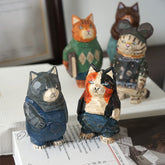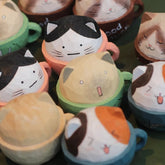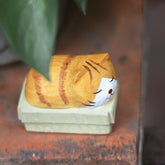How to Carve Fish Scale Patterns on Wooden Gifts
Have you ever finished carving wooden gifts, only to feel like they still look a bit plain? Try adding fish scale patterns and varying textures! These simple techniques can bring your pieces to life and make them look more dynamic.
Step 1: Carving Vertical Lines
To create straight, vertical grooves, we can start with a straight-edged knife.


By making two cuts, a small chip of wood naturally falls out, forming a clean line. Then, repeat this process for each vertical line. At first, every line looks the same—but that’s not what we want! We want some variation in width and depth to make the design more interesting.
For this reason, a utility knife is often a better choice. It requires more carving strokes, but it allows for subtle differences in thickness, giving your wooden gifts a more organic look.


Step 2: Adding More Texture
Now that the basic grooves are done, let’s refine the details near the base. If you want to add some uneven texture to the surface—like on the mushroom cap—there are a few different ways to do it. Almost any carving knife can create fish scale patterns, but each will produce a slightly different effect.



Let’s test out some different tools on a scrap piece of wood to see how they each perform.

Step 3: Testing Different Gouges
First, we’ll use a 5mm round gouge. The result looks like this:

Now, let’s try another gouge with a similar curve. Since the shape is almost the same, the effect is very similar.

What if we use a larger gouge with the same curve? Let’s switch to an 8mm gouge. As expected, the bigger the gouge, the larger the pattern. So if you’re working on larger wooden gifts, you might want to scale up your tools accordingly.

Next, let’s test a shallow round gouge. Since it doesn’t cut as deep, the pattern is a bit more subtle.

Step 4: Trying Different Specialty Knives
Now, let’s experiment with a pelican knife. Think of it as a round gouge with a wider curve. Compared to a razor blade, it creates softer, shallower cuts, making it less suitable for very small fish scale patterns. However, if you scale up your carving, it works much better!

We can also try a larger pelican knife, which removes even bigger wood chips. See the pattern here? The bigger your tools, the bigger your carvings! Every tool can create fish scale textures—it’s just a matter of choosing the right one for your project. The size and style of your wooden gifts will determine which tool is best. At the end of the day, tools are just a means to an end—pick the one that helps you achieve your vision.
Finally, here’s how the finished pattern looks. It almost resembles a tiny hat! So, why not give it some personality? Let’s add eyes and a nose. There are no rules here—feel free to get creative!


Step 5: Finishing Touches
Don’t overthink it—this is just practice! Let your creativity flow and see where it takes you. If you have a pyrography pen, you can use it to add depth, enhance the lines, and even burn away tiny wood fibers for a cleaner look.

And that’s it! Our little mushroom figurine is finally complete.












